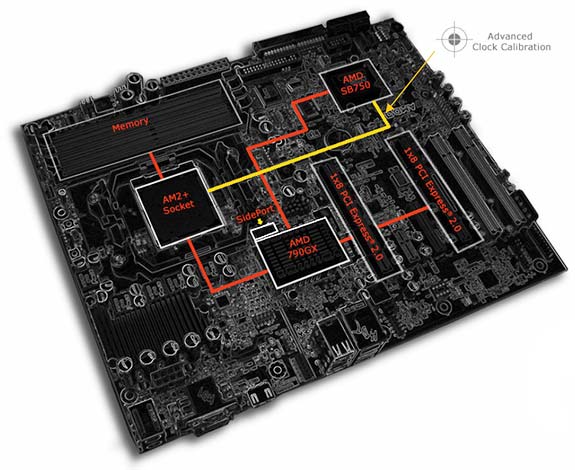AMD 790GX Chipset Platform Launch
To evaluate the new AMD 790GX chipset, we got out hands on a retail ready motherboard from Gigabyte, the MA790GP-DS4H.
The Gigabyte MA790GP-DS4H exposed all of the features inherent to the 790GX and adds many more through the use of additional on-board controllers. As you can see, the board is passively cooled by an array of copper heatsinks linked together via a pair of copper heatpipes, and is this completely silent. During testing, we found the heatsinks to get just warm to the touch so heat should not be an issue here.
The board is outfitted with three PCI Express x1 slots, two x16 PEG slot (with x8 electrical connections) and two standard PCI slots. All of its main connectors and headers are situated around the edges of the board, save for a band of four USB headers, located just behind the third x1 slot. The board’s headers are clearly marked, labeled, and color coded, which made working with the MA790GP-DS4H a breeze during setup. Overall we found the layout to be good.
In the MA790GP-DS4H’s external I/O port cluster, you’ll find PS/2 mouse and keyboard ports, VGA, DVI, and HDMI display outputs (any two can be used simultaneoudly with only the IGP), four USB ports, analog and digital HD audio outputs, a Gigabit LAN port, and finally a Firewire port. The board’s audio comes by way of a Realtek ALC889A 8-Channel HD codec, Firewire by way of a TI controller, and Gigabit LAN duties are handled by a Realtek RLT8111 chip.
We should also note, that the MA790GP-DS4H's integrated Radeon HD 3300 IGP is backed by 128MB of 1333MHz dedicated frame buffer memory. Having dedicated frame buffer memory (dubbed sideport memory), makes the IGP essentially act like a discreet graphics card because system memory will be used less frequently. The combination of the higher clocked graphics core and dedicated sideport memory are what make the 790GX a better performer than the 780G, and what arguably make it the best IGP on the market today, in terms of both features and performance.

One of the 790GX's more interesting features comes by way of the SB750 Southbridge. Dubbed ACC, short for Advanced Clock Calibration, the feature is designed to enhance the overclocking potential of Phenom processors. AMD hasn't revealed exactly how the technology works, but its name and the fact that the Southbridge now has a dedicated link to the CPU, speaks to ACC's ability to keep clock frequencies in sync and stabilize inter-chip communications between the CPU, Northbridge, Southbridge and memory.
AMD Phenom 9850 Overclocked to 3.1GHz
To test ACC we overclocked our Phenom X4 9850 processor using the latest version of AMD's Overdrive utility. This particular CPU has trouble running at 2.9GHz on other motherboards, and completed a suite of benchmarks at only 2.8GHz when we first evaluated the chip. With it installed in the Gigabyte MA790GP-DS4H though, with ACC enabled, this very same chip had no trouble hitting 3.1GHz--an effective increase of 600MHz over stock and 300MHz increase over other motherboards that don't feature ACC. That is an impressive feat, and makes this platform the one to own currently if you're an AMD aficionado.







